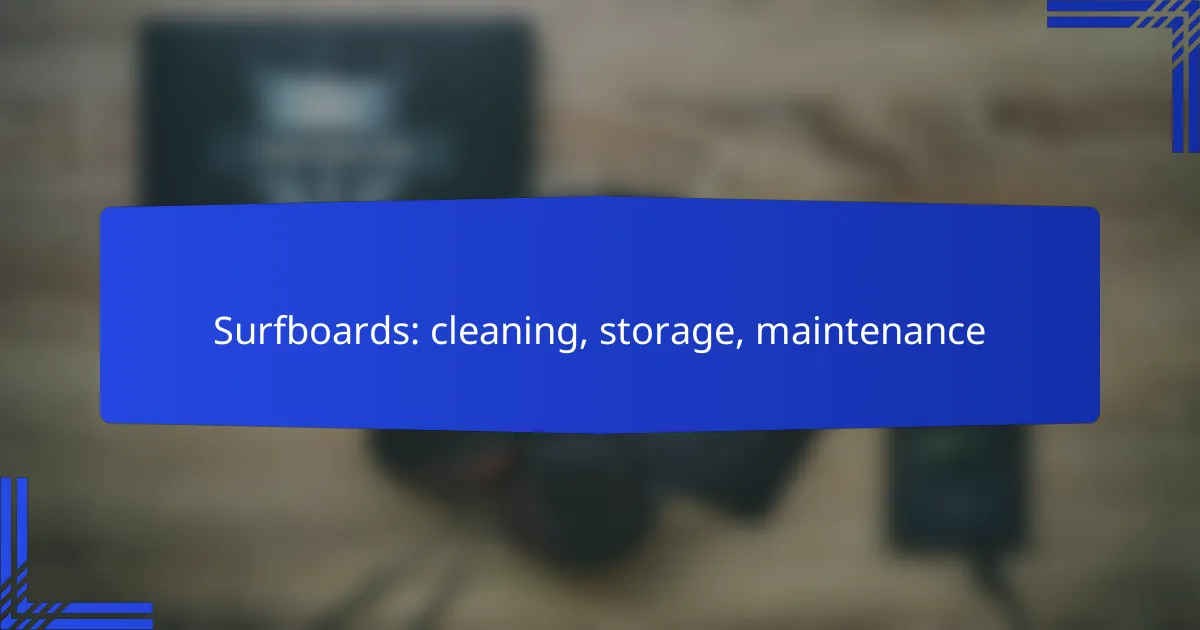Proper care of surfboards is essential for maintaining their performance and longevity. This includes effective cleaning techniques, appropriate storage practices, and regular maintenance checks. By using gentle cleaning agents and protective gear, surfers can ensure their boards remain in optimal condition for every ride.

How to clean surfboards effectively?
Cleaning surfboards effectively involves using gentle cleaning agents and proper techniques to avoid damaging the board’s surface. Regular maintenance helps prolong the lifespan of your surfboard and ensures optimal performance in the water.
Use mild soap and water
Start by mixing a small amount of mild soap with fresh water in a bucket. Avoid harsh chemicals or abrasive cleaners, as they can damage the surfboard’s finish and materials.
Using mild soap helps remove dirt, salt, and other residues without harming the board. Aim for a solution that is gentle enough for delicate surfaces yet effective in cleaning.
Apply a soft sponge or cloth
Once you have your soapy water ready, use a soft sponge or cloth to gently scrub the surface of the surfboard. This helps lift grime without scratching the board.
Be thorough but gentle, focusing on areas where dirt tends to accumulate, such as the tail and nose. Avoid using scouring pads or rough materials that could cause scratches.
Rinse thoroughly with fresh water
After cleaning, it is crucial to rinse the surfboard thoroughly with fresh water to remove any soap residue. Soap left on the board can attract dirt and lead to discoloration over time.
Use a hose or a bucket of fresh water, ensuring that all areas of the board are rinsed well. Pay special attention to the fins and any crevices where soap might linger.
Dry with a microfiber towel
To finish the cleaning process, dry the surfboard with a microfiber towel. This material is effective at absorbing moisture without leaving lint or scratches.
Gently pat the board dry rather than rubbing it, as this can help prevent any potential damage to the surface. Make sure the board is completely dry before storing it to avoid mold or mildew growth.

What are the best storage practices for surfboards in New Zealand?
The best storage practices for surfboards in New Zealand involve keeping them in a cool, dry environment, using protective gear like board bags, and ensuring they are stored either upright or horizontally. These methods help maintain the integrity of the surfboard and prolong its lifespan.
Store in a cool, dry place
Storing your surfboard in a cool, dry place is essential to prevent damage from heat and humidity. Ideal storage temperatures are typically between 15°C to 25°C, avoiding direct sunlight which can warp the board. A garage or a dedicated storage room works well, as long as it is well-ventilated.
Humidity can lead to mold and mildew, particularly in coastal areas of New Zealand. Consider using a dehumidifier if your storage area tends to be damp, especially during the wet season.
Use a board bag for protection
A quality board bag is crucial for protecting your surfboard from dings, scratches, and UV damage. Look for bags with padding and UV-resistant materials to ensure maximum protection. A good bag will also help keep your board clean and free from dust and debris.
When selecting a board bag, consider the size and type of your surfboard. A snug fit will prevent movement during transport and storage, reducing the risk of damage.
Keep upright or horizontal
Storing your surfboard upright or horizontally helps maintain its shape and prevents warping. If storing upright, use a rack or wall mount that supports the board at its center. For horizontal storage, place the board on a soft surface like a carpet or foam padding to avoid pressure points.
Avoid leaning your surfboard against walls or other objects, as this can create stress points that may lead to cracks or other damage over time. Regularly check your board for any signs of wear or damage, especially if it has been stored for an extended period.

How to maintain surfboards for longevity?
Maintaining surfboards properly can significantly extend their lifespan and performance. Key practices include regular inspections, applying protective products, and ensuring all components are in good condition.
Regularly check for dings and repairs
Inspect your surfboard frequently for dings, cracks, or other damage. Even small dings can lead to water intrusion, which may compromise the board’s integrity over time.
To repair minor dings, use a surfboard repair kit, which typically includes resin and fiberglass cloth. For larger damages, consider consulting a professional repair service to ensure proper restoration.
Apply UV protectant wax
Using UV protectant wax is essential for safeguarding your surfboard from sun damage. This type of wax creates a barrier that helps prevent the board’s materials from degrading due to prolonged sun exposure.
Apply the wax after cleaning your board and before storage, especially if you plan to leave it in direct sunlight. Reapply every few sessions or as needed, depending on the conditions you surf in.
Inspect fins and leash regularly
Regularly checking your fins and leash is crucial for safe surfing. Ensure that fins are securely attached and free from cracks or other damage that could affect performance.
Inspect the leash for any signs of wear, such as fraying or weak spots. Replace it if you notice any damage to avoid losing your board while surfing.

What are the common mistakes in surfboard maintenance?
Common mistakes in surfboard maintenance include improper storage, using inappropriate cleaning products, and exposing the board to harsh environmental conditions. These errors can lead to damage, reduced performance, and a shorter lifespan for your surfboard.
Leaving in direct sunlight
Exposing your surfboard to direct sunlight can cause the resin to weaken and the colors to fade. Prolonged exposure may lead to delamination, where the layers of the board begin to separate. To avoid this, store your surfboard in a shaded area or use a board bag with UV protection.
When transporting your surfboard, consider covering it with a towel or a dedicated surfboard bag to minimize sun exposure. This simple step can significantly extend the life of your board.
Using harsh cleaning chemicals
Using harsh chemicals can damage the surfboard’s surface and degrade the materials over time. Products containing bleach or ammonia can strip away protective coatings and lead to discoloration. Instead, opt for mild soap and water for cleaning.
For stubborn stains, consider using a specialized surfboard cleaner that is safe for the materials. Always rinse thoroughly after cleaning to remove any residue that could cause future damage.
Storing in damp environments
Storing your surfboard in damp environments can promote mold and mildew growth, which can damage the board and affect its performance. Ideally, keep your surfboard in a cool, dry place with good ventilation. Avoid basements or areas prone to humidity.
If you must store your board in a less-than-ideal environment, consider using a dehumidifier or moisture-absorbing products to help control humidity levels. Regularly check your board for signs of moisture damage to catch any issues early.

What tools are essential for surfboard maintenance?
Essential tools for surfboard maintenance include items that help with repairs, cleaning, and waxing. Having the right tools ensures your surfboard remains in good condition, enhancing its performance and longevity.
Surfboard repair kit
A surfboard repair kit typically contains epoxy resin, fiberglass cloth, sandpaper, and mixing tools. These items are crucial for fixing dings, cracks, or other damage that can occur during use.
When selecting a repair kit, consider the type of surfboard you have, as some kits are designed specifically for foam or fiberglass boards. Regularly check your kit to ensure you have all necessary components, especially before heading out for a surf session.
Soft cloths and sponges
Soft cloths and sponges are essential for cleaning your surfboard without scratching its surface. Use these tools to wipe off saltwater, sand, and dirt after each session to prevent buildup that can damage the board over time.
Microfiber cloths are particularly effective as they absorb moisture well and leave no lint behind. Avoid using abrasive materials, as they can create micro-scratches that affect the board’s performance.
Wax comb and applicator
A wax comb and applicator are vital for maintaining the grip on your surfboard. The comb helps remove old wax and smooth out new layers, ensuring optimal traction while surfing.
When applying wax, use the applicator to create a textured surface that enhances grip. Regularly check your wax layer, especially in warmer conditions, as it can wear down quickly, requiring reapplication for best performance.

How to choose the right surfboard bag?
Choosing the right surfboard bag is essential for protecting your board during transport and storage. Consider factors such as size, fit, material, and additional features to ensure your surfboard remains in optimal condition.
Consider size and fit
When selecting a surfboard bag, the size and fit are crucial. The bag should accommodate your surfboard’s dimensions, including length, width, and thickness, while allowing for some extra space for padding. A well-fitted bag prevents movement during transport, reducing the risk of damage.
Measure your surfboard accurately before shopping. Most bags come in standard sizes, so look for a bag that matches your board’s specifications. If your board is on the larger side, consider a bag with a bit more room to accommodate any accessories, like fins or leashes.
Additionally, check the bag’s internal padding. A bag with thick padding will provide better protection against impacts. If you frequently travel or store your board in a high-risk environment, investing in a padded bag is advisable.
